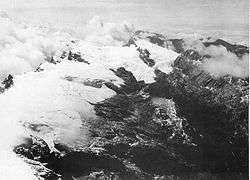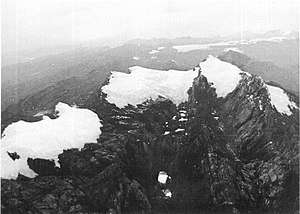Carstensz Glacier
The Carstensz Glacier is near the peak of Puncak Jaya (sometimes called Mount Carstensz or the Carstensz Pyramid) which is a mountain in the Sudirman Range of the island of New Guinea, territorially the western central highlands of Papua province, Indonesia. The glacier is situated at an elevation of approximately 4,600 metres (15,100 ft) and is 1.5 kilometres (0.93 mi) east of the summit tower of Puncak Jaya. In 2002 the Carstensz Glacier was 1.4 kilometres (0.87 mi) in length and .60 kilometres (0.37 mi) wide.
| Carstensz Glacier | |
|---|---|
 The Carstensz Glacier is at lower right in this 2005 image. The circular depression to the left is the Grasberg mine, the world's largest gold mine. | |
| Type | Mountain glacier |
| Location | Puncak Jaya, Sudirman Range, Papua province, Indonesia |
| Coordinates | 04°04′59.32″S 137°10′44.77″E |
| Area | 0.09824 km2 (0.03793 sq mi) in 2018[1] |
| Length | 1.4 km (0.87 mi) |
| Terminus | Rockfall |
| Status | Retreating |
The glacier is named after the 17th century Dutch explorer Jan Carstenszoon, commonly known as Jan Carstensz.
Background


Research presented in 2004 of IKONOS satellite imagery of the New Guinean glaciers indicated that in the two years from 2000 to 2002, the Carstensz Glacier had lost a further 6.8% of its surface area.[2] An expedition to the remaining glaciers on Puncak Jaya in 2010 discovered that the ice on the glaciers there is about 32 metres (105 ft) thick and thinning at a rate of 7 metres (23 ft) annually. At that rate, the remaining glaciers in the immediate region near Puncak Jaya were expected to last only to the year 2015.[3][4]

The remaining remnant glaciers on Punkak Jaya were once part of an icecap that developed approximately 5,000 years ago. At least one previous icecap also existed in the region between 15,000 and 7,000 years ago, when it also apparently melted away and disappeared.[2]
References
- Suwandi, Rizaldi; Sani M. Isa (2020). "Detection and Measure Carstensz Glacier Area Changes using Machine Learning Technique" (pdf). International Journal of Innovative Technology and Exploring Engineering (IJITEE). pp. 1397–1404. Retrieved 2020-02-02.
- Kincaid, Joni L.; Andrew G Klein (2004). "Retreat of the Irian Jaya Glaciers from 2000 to 2002" (pdf). 61st Eastern Snow Conference. pp. 147–157. Retrieved 2011-11-03.
- McDowell, Robin (July 1, 2010). "Indonesia's Last Glacier Will Melt 'Within Years'". Jakarta Globe. Retrieved 2011-11-03.
- "Papua Glacier's Secrets Dripping Away: Scientists". Jakarta Globe. July 2, 2010. Retrieved 2011-11-03.